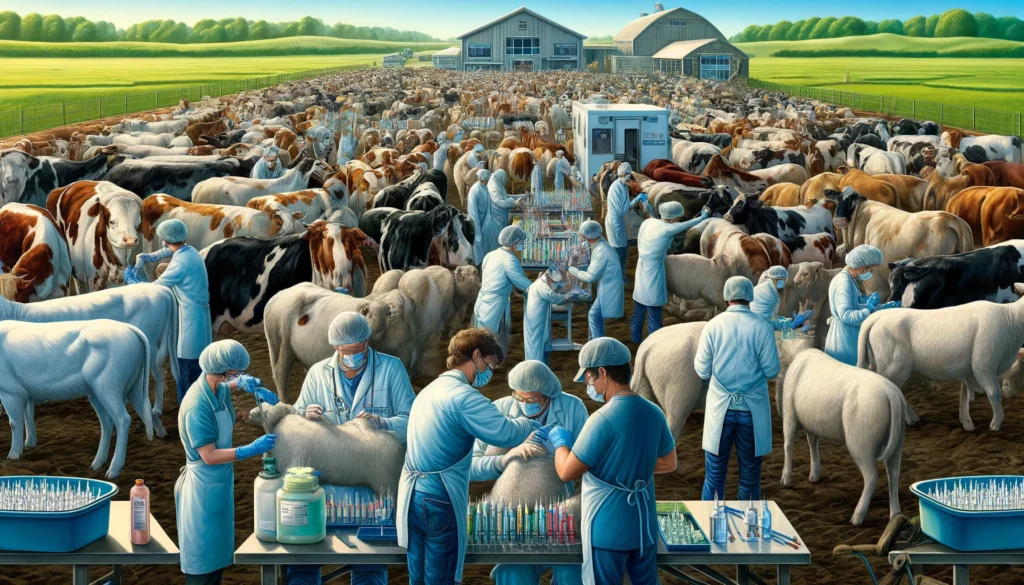
Vaccination Programs A vivid and detailed illustration of a large scale vaccination program for a herd of farm animals. The scene shows several farmers and veterinarians a 2.webp.webp

Vaccination Programs
Definition:
Vaccination programs in livestock management refer to systematic strategies for administering vaccines to prevent infectious diseases and promote herd health and productivity. Vaccination plays a crucial role in disease prevention and control by stimulating the animal’s immune system to recognize and combat specific pathogens, thereby reducing the risk of disease transmission and minimizing economic losses associated with illness and treatment.
Importance of Vaccination:
- Disease Prevention: Vaccination programs help protect livestock from a wide range of infectious diseases, including viral, bacterial, and parasitic pathogens that pose significant health threats to animal populations. By inducing immunity against specific diseases, vaccines reduce the likelihood of disease outbreaks and limit the spread of pathogens within and between herds.
- Herd Health Management: Vaccination is an integral component of comprehensive herd health management plans aimed at maintaining the overall health, productivity, and profitability of livestock operations. By reducing the incidence and severity of infectious diseases, vaccination programs contribute to improved production outcomes, reproductive performance, and animal welfare.
- Economic Benefits: Vaccination offers economic benefits to livestock producers by reducing the costs associated with disease treatment, veterinary interventions, and production losses attributable to morbidity, mortality, and reduced growth or reproductive efficiency. Investing in preventive vaccination measures yields long-term returns through enhanced herd health and performance.
Principles of Vaccination:
- Selection of Vaccines: Choosing appropriate vaccines based on the prevalent diseases in the region, specific production goals, and the immunological needs of the target animal species is essential for effective disease control. Vaccines should be selected based on their safety, efficacy, and compatibility with existing vaccination protocols.
- Vaccination Timing: Timing of vaccination is critical to maximize immune response and protection against target diseases. Vaccines may be administered to young animals shortly after birth to provide passive immunity from colostrum or through a series of booster doses to induce active immunity over time. Strategic timing of vaccinations before periods of increased disease risk, such as weaning or transportation, enhances protection and reduces susceptibility to infections.
- Administration and Handling: Proper administration techniques and vaccine handling practices are essential to ensure vaccine efficacy and minimize the risk of adverse reactions. Vaccines should be stored and transported according to manufacturer recommendations, administered using sterile equipment and techniques, and documented accurately to track vaccination history and compliance.
- Monitoring and Evaluation: Monitoring vaccine effectiveness, disease prevalence, and herd health status through regular surveillance and diagnostic testing helps evaluate the impact of vaccination programs and identify areas for improvement. Adjustments to vaccination protocols may be necessary based on changes in disease prevalence, emerging pathogens, or vaccine technology advancements.
Types of Vaccines:
- Live Attenuated Vaccines: Live vaccines contain weakened or attenuated forms of the target pathogen, which stimulate a strong immune response without causing disease. Examples include modified live virus (MLV) vaccines used for diseases such as bovine viral diarrhea (BVD) and infectious bovine rhinotracheitis (IBR).
- Inactivated Vaccines: Inactivated vaccines contain killed or inactivated forms of the pathogen, which stimulate an immune response without causing active infection. These vaccines are commonly used for diseases such as foot-and-mouth disease (FMD) and avian influenza (AI) in livestock.
- Subunit Vaccines: Subunit vaccines contain specific components or antigens of the pathogen, such as proteins or polysaccharides, to induce immunity. These vaccines are safer and more targeted than whole-cell vaccines but may require adjuvants or multiple doses to enhance immune response. Examples include vaccines against Clostridial diseases in ruminants.
Implementation Considerations:
- Customized Vaccination Protocols: Tailoring vaccination protocols to the specific needs and disease risks of individual farms or production systems enhances the effectiveness and cost-efficiency of vaccination programs. Consultation with veterinary professionals and disease surveillance data helps identify priority diseases and design targeted vaccination strategies.
- Adherence to Best Practices: Following best practices in vaccine administration, storage, and handling ensures vaccine efficacy and safety. Training personnel in proper vaccination techniques, maintaining cold chain integrity, and documenting vaccine usage and outcomes support compliance with recommended guidelines and regulatory standards.
- Biosecurity and Disease Management: Vaccination should be integrated with comprehensive biosecurity and disease management practices to minimize disease introduction and transmission within and between animal populations. Implementing biosecurity measures, such as quarantine, sanitation, and herd health monitoring, complements vaccination efforts and enhances overall disease control.
Conclusion:
Vaccination programs are integral to livestock health management, providing effective protection against infectious diseases and supporting sustainable and profitable animal production. By embracing principles of vaccination, selecting appropriate vaccines, implementing tailored vaccination protocols, and integrating vaccination with comprehensive disease management strategies, livestock producers can safeguard herd health, enhance productivity, and contribute to the resilience and viability of their operations amidst evolving disease challenges and production demands.
Fall off the barn roof and busted your keister? Life on the farm or ranch can be tough on the bum. Need a break? Laugh it off at FarmerCowboy.com, the #1 farm humor site. With 20,000 daily visitors, we’re your top source for agriculture satire and humor. Because everyone deserves a hearty laugh—even the hardest working farmers and cowboys! Join us and turn those long days into fun tales at FarmerCowboy.com.

Originally posted 2022-10-15 15:37:04.
Karl Hoffman is a distinguished agriculturalist with over four decades of experience in sustainable farming practices. He holds a Ph.D. in Agronomy from Cornell University and has made significant contributions as a professor at Iowa State University. Hoffman’s groundbreaking research on integrated pest management and soil health has revolutionized modern agriculture. As a respected farm journalist, his column “Field Notes with Karl Hoffman” and his blog “The Modern Farmer” provide insightful, practical advice to a global audience. Hoffman’s work with the USDA and the United Nations FAO has enhanced food security worldwide. His awards include the USDA’s Distinguished Service Award and the World Food Prize, reflecting his profound impact on agriculture and sustainability.



